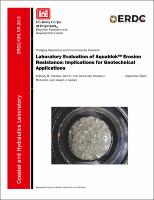Please use this identifier to cite or link to this item:
https://hdl.handle.net/11681/38140Full metadata record
| DC Field | Value | Language |
|---|---|---|
| dc.contributor.author | Priestas, Anthony M. | - |
| dc.contributor.author | Hull, John H. | - |
| dc.contributor.author | McKenzie, Charles F. | - |
| dc.contributor.author | Gailani, Joseph Z. | - |
| dc.contributor.author | Ellis, Reed | en_US |
| dc.date.accessioned | 2020-09-16T17:55:27Z | - |
| dc.date.available | 2020-09-16T17:55:27Z | - |
| dc.date.issued | 2020-09 | - |
| dc.identifier.govdoc | ERDC/CHL SR-20-3 | - |
| dc.identifier.uri | https://hdl.handle.net/11681/38140 | - |
| dc.identifier.uri | http://dx.doi.org/10.21079/11681/38140 | - |
| dc.description | Special Report | - |
| dc.description.abstract | AquaBlok™ (AB) is a commercial product traditionally used as an alternative material for contaminated sediment capping applications. Previous studies of AB capping performance have reported enhanced stabilization through increased erosion resistance. Subsequently, AB has been considered for use as an alternative levee repair material due to its cohesive properties. Through a series of laboratory experiments, this study investigated the erosion behavior of new AquaBlok formulations (10%, 20%, and 30% clay by weight) under increased shear stresses previously unachievable in the previous tests. The new AquaBlok formulations were tested in non-compacted and compacted states to simulate the physical properties in capping and levee repair applications. In the non-compacted state, excess hydration of the clay matrix extended approximately 5 cm below the bed surface, which greatly reduced erosion resistance and was independent of clay percentage. Below this horizon, critical shear stress increased, and erosion rates decreased, with clay percentage, respectively. However, this does not consider a continuous change in hydration state when exposed to free water. In the compacted state, erosion rates were greatly arrested, with measureable erosion only possible under the maximum applied shear stress (24 Pa). The results are discussed in the context of capping and levee applications. | en_US |
| dc.description.sponsorship | Dredging Operations and Environmental Research Program (U.S.) | en_US |
| dc.description.tableofcontents | Abstract .................................................................................................................................... ii Figures and Tables ................................................................................................................... v Preface .................................................................................................................................... vii 1 Introduction ...................................................................................................................... 1 1.1 Background ........................................................................................................ 1 1.2 Objectives ........................................................................................................... 2 1.3 Approach ............................................................................................................ 3 2 Materials and Methods ................................................................................................... 4 2.1 AquaBlok (AB) description ................................................................................. 4 2.2 Erosion testing ................................................................................................... 5 2.2.1 Sedflume apparatus and test procedure ................................................................... 5 2.2.2 Non-compacted core preparation and erosion test procedure ................................ 7 2.2.3 Compacted core preparation and erosion test procedure ....................................... 9 2.3 Density scans .................................................................................................. 12 2.4 Data analysis .................................................................................................. 13 3 Results ............................................................................................................................. 14 3.1 Non-compacted cores ..................................................................................... 14 3.1.1 General observations ................................................................................................ 14 3.1.2 Erosion test results ................................................................................................... 16 3.2 Compacted cores ............................................................................................. 24 3.2.1 X-Ray Attenuation (XRA)-derived bulk density ......................................................... 24 3.2.2 Erosion test results ................................................................................................... 25 4 Discussion ....................................................................................................................... 29 4.1 Non-compacted cores .................................................................................... 29 4.1.1 Factors affecting erosion resistance........................................................................ 31 4.1.2 Comparison of AB erosion resistance to previous work ......................................... 33 4.1.3 Implications for capping applications ...................................................................... 36 4.2 Compacted cores ............................................................................................ 38 4.2.1 Potential use as a levee repair material .................................................................. 40 4.2.2 Potential use as an embankment dam core material ............................................ 41 4.3 Considerations for AB formulations ............................................................... 42 5 Conclusions and Recommendations ........................................................................... 44 References ............................................................................................................................. 47 Appendix A: Description of XRA-derived Bulk Density ..................................................... 50 Appendix B: Derivation of Depth to Apply Depth-Averaged Velocity in a Log-Velocity Distribution ............................................................................................... 52 Unit Conversion Factors ....................................................................................................... 54 Acronyms and Abbreviations ............................................................................................... 55 Report Documentation Page | - |
| dc.format.extent | 65 pages / 5.96 MB | - |
| dc.format.medium | - | |
| dc.language.iso | en_US | en_US |
| dc.publisher | Coastal and Hydraulics Laboratory (U.S.) | en_US |
| dc.publisher | Engineer Research and Development Center (U.S.) | - |
| dc.relation.ispartofseries | Special Report (Engineer Research and Development Center (U.S.)) ; no. ERDC/CHL SR-20-3 | - |
| dc.rights | Approved for Public Release; Distribution is Unlimited | - |
| dc.source | This Digital Resource was created in Microsoft Word and Adobe Acrobat | - |
| dc.subject | Earth dams--Erosion | en_US |
| dc.subject | Earth dams--Maintenance and repair | en_US |
| dc.subject | Levees--Erosion | en_US |
| dc.subject | Levees--Maintenance and repair | en_US |
| dc.subject | Materials--Erosion | en_US |
| dc.subject | Materials--Evaluation | en_US |
| dc.title | Laboratory evaluation of Aquablok™ erosion resistance : implications for geotechnical applications | en_US |
| dc.type | Report | en_US |
| Appears in Collections: | Special Report | |
Files in This Item:
| File | Description | Size | Format | |
|---|---|---|---|---|
| ERDC-CHL SR-20-3.pdf | 5.96 MB | Adobe PDF |  View/Open |